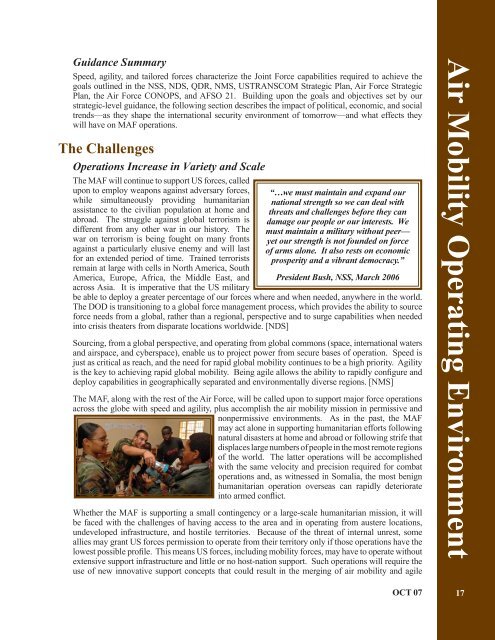Air Mobility Plan, 2008 - The Black Vault
Air Mobility Plan, 2008 - The Black Vault
Air Mobility Plan, 2008 - The Black Vault
Create successful ePaper yourself
Turn your PDF publications into a flip-book with our unique Google optimized e-Paper software.
Guidance Summary<br />
Speed, agility, and tailored forces characterize the Joint Force capabilities required to achieve the<br />
goals outlined in the NSS, NDS, QDR, NMS, USTRANSCOM Strategic <strong>Plan</strong>, <strong>Air</strong> Force Strategic<br />
<strong>Plan</strong>, the <strong>Air</strong> Force CONOPS, and AFSO 21. Building upon the goals and objectives set by our<br />
strategic-level guidance, the following section describes the impact of political, economic, and social<br />
trends—as they shape the international security environment of tomorrow—and what effects they<br />
will have on MAF operations.<br />
<strong>The</strong> Challenges<br />
Operations Increase in Variety and Scale<br />
<strong>The</strong> MAF will continue to support US forces, called<br />
upon to employ weapons against adversary forces,<br />
while simultaneously providing humanitarian<br />
assistance to the civilian population at home and<br />
abroad. <strong>The</strong> struggle against global terrorism is<br />
different from any other war in our history. <strong>The</strong><br />
war on terrorism is being fought on many fronts<br />
against a particularly elusive enemy and will last<br />
for an extended period of time. Trained terrorists<br />
remain at large with cells in North America, South<br />
America, Europe, Africa, the Middle East, and<br />
across Asia. It is imperative that the US military<br />
“…we must maintain and expand our<br />
national strength so we can deal with<br />
threats and challenges before they can<br />
damage our people or our interests. We<br />
must maintain a military without peer—<br />
yet our strength is not founded on force<br />
of arms alone. It also rests on economic<br />
prosperity and a vibrant democracy.”<br />
President Bush, NSS, March 2006<br />
be able to deploy a greater percentage of our forces where and when needed, anywhere in the world.<br />
<strong>The</strong> DOD is transitioning to a global force management process, which provides the ability to source<br />
force needs from a global, rather than a regional, perspective and to surge capabilities when needed<br />
into crisis theaters from disparate locations worldwide. [NDS]<br />
Sourcing, from a global perspective, and operating from global commons (space, international waters<br />
and airspace, and cyberspace), enable us to project power from secure bases of operation. Speed is<br />
just as critical as reach, and the need for rapid global mobility continues to be a high priority. Agility<br />
is the key to achieving rapid global mobility. Being agile allows the ability to rapidly configure and<br />
deploy capabilities in geographically separated and environmentally diverse regions. [NMS]<br />
<strong>The</strong> MAF, along with the rest of the <strong>Air</strong> Force, will be called upon to support major force operations<br />
across the globe with speed and agility, plus accomplish the air mobility mission in permissive and<br />
nonpermissive environments. As in the past, the MAF<br />
may act alone in supporting humanitarian efforts following<br />
natural disasters at home and abroad or following strife that<br />
displaces large numbers of people in the most remote regions<br />
of the world. <strong>The</strong> latter operations will be accomplished<br />
with the same velocity and precision required for combat<br />
operations and, as witnessed in Somalia, the most benign<br />
humanitarian operation overseas can rapidly deteriorate<br />
into armed conflict.<br />
Whether the MAF is supporting a small contingency or a large-scale humanitarian mission, it will<br />
be faced with the challenges of having access to the area and in operating from austere locations,<br />
undeveloped infrastructure, and hostile territories. Because of the threat of internal unrest, some<br />
allies may grant US forces permission to operate from their territory only if those operations have the<br />
lowest possible profile. This means US forces, including mobility forces, may have to operate without<br />
extensive support infrastructure and little or no host-nation support. Such operations will require the<br />
use of new innovative support concepts that could result in the merging of air mobility and agile<br />
<strong>Air</strong> <strong>Mobility</strong> Operating Environment<br />
OCT 07<br />
17
















